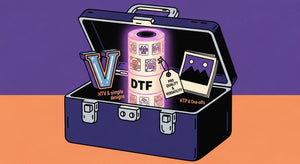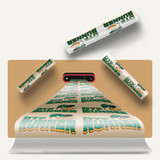Table of Contents
- Why Workspace Setup Matters for DTF Prints
- Choosing the Right Location
- Essential Equipment for DTF Prints
- Organizing Your Workspace
- Setting Up Equipment for Optimal DTF Prints
- Workflow Optimization for DTF Prints
- Enhancing Efficiency with Technology
- Safety Measures in Your DTF Printing Workspace
- Marketing Your DTF Prints Business
- Additional Tips for DTF Printing Success
- Well at the end it is all about DTF prints
Swirl into the world of to DTF Prints
Direct-to-film (DTF) printing is an innovative method that produces high-quality, durable prints on various fabrics. Setting up your workspace for DTF prints requires careful planning to ensure efficiency, safety, and high-quality output. In this guide, we’ll explore how to create an optimal workspace for DTF printing, ensuring your environment is conducive to producing the best possible DTF prints.
Why Workspace Setup Matters for DTF Prints
A clean, organized, and fully equipped workspace is important for the best results on DTF prints. It helps you avoid unnecessary errors and risks, increases productivity, and is safer. Moreover, this enables you to have an easier workflow and quality control, hence producing the best quality DTF prints.

Choosing the Right Location
Space Requirements
First, set up your workspace appropriately by choosing the right and perfect place. Your workspace should be large enough to hold all the essential devices and materials. Make sure there's enough space to accommodate a DTF printer, a heat press, a curing oven, and storage space for films and inks.
Ventilation and Lighting
Proper ventilation is essential to prevent the buildup of fumes from inks and adhesives. Good lighting is also important for detailed design work and inspecting prints for quality. Natural light is ideal, but if that’s not possible, you can buy high-quality artificial lighting that mimics natural light.
Essential Equipment for DTF Prints
DTF Printer
You need a high-quality DTF printer for your workspace. Choose a printer that offers excellent resolution and is compatible with your specific printing needs. Brands like Epson and Roland offer reliable options for DTF printing.
Heat Press
The heat press is used to transfer your printed design onto fabric. Opt for a heat press with adjustable pressure and temperature settings to ensure consistent and high-quality transfers. The size of the heat press should match the typical size of your DTF prints.
Curing Oven
A curing oven is necessary to set the adhesive powder applied to DTF prints. Ensure the oven is large enough to handle your typical workload and has precise temperature controls.
DTF Film and Ink
Use high-quality DTF film and ink to ensure vibrant and durable prints. Store these materials in a cool, dry place to maintain their quality. Make sure to have enough inventory to meet your production needs.

Organizing Your Workspace
Layout Planning
Plan the layout of the workspace. Set up your equipment in order of use, starting with a design station, followed directly by a printing area. Then there will be the curing station and, lastly, the heat press. This minimizes movement and maximizes efficiency most effectively.
Storage Solutions
Collaborate on plans for a storage solution that will keep your work organized. Shelves, drawers, and bins can hold films, inks, and all other supplies. Label all your storage containers for ease of identification and easy access. This relieves clutter and maximizes productivity.
Ergonomic Considerations
Ergonomics is important for comfort and safety. Ensure worktables are at comfortable heights to avoid straining the body. Adjustable chairs with proper back support will help in working comfortably. Organize your tools and materials in a way that they are easily available at hand to minimize repetitive stress.
Setting Up Equipment for Optimal DTF Prints
Printer Setup
Place your DTF printer on a sturdy, level surface. Ensure it is connected to a reliable power source and has adequate ventilation. Regularly clean and maintain the printer to prevent clogs and ensure consistent print quality.
Heat Press Setup
Place your heat press in a well-ventilated area. It has to be stable and leveled to allow pressure to act uniformly during transfers. Check that the temperature and pressure settings are adjusted in accordance with the manufacturer's recommendations for DTF prints.
Curing Oven Setup
Set up the curing oven in a well-ventilated area away from highly flammable materials. Ensure the equipment is put on a stable surface and positioned far enough away from all flammable material. Check temperature accuracy often in the oven and maintain its functionality per the recommendations of the manufacturer.
Workflow Optimization for DTF Prints
Streamlining Processes
Optimize your workflow by streamlining processes. Create a step-by-step checklist for each DTF print project, from design creation to final transfer. This approach reduces the risk of errors and ensures a consistent process.
Quality Control
Install a quality control system that checks every print for defects or inconsistencies. Check color accuracy, alignment, and total quality of print. Any kind of defects must be dealt with to preserve high standards for DTF prints.
Maintenance Schedule
Regular maintenance is essential for keeping your equipment in top condition. Establish a maintenance schedule for cleaning and servicing your DTF printer, heat press, and curing oven. This proactive approach prevents breakdowns and extends the lifespan of your equipment.
Enhancing Efficiency with Technology
Design Software
Invest in high-quality design software to create stunning DTF prints. Programs like Adobe Illustrator, CorelDRAW, and Photoshop offer robust tools for detailed design work. Ensure your software is up to date to take advantage of the latest features and improvements.
Automation Tools
Consider integrating automation tools to enhance efficiency. Automated cutting, besides software designed to help in making the printing process easy, will save on time and manual effort. Find options that integrate seamlessly with your setup.
Monitoring Systems
Monitor your production workflow and the performance of your equipment through the installed monitoring systems. Such systems can notify you of forthcoming problems before they become significant ones, providing seamless operation and high-quality DTF printing.
Safety Measures in Your DTF Printing Workspace
Handling Inks and Adhesives
Handling DTF inks and adhesives can be hazardous, so wearing gloves and masks is important. The workplace area should be adequately ventilated so that one could avoid fumes. Details on safety measures provided by manufacturers should be followed.
Electrical Safety
Ensure all electrical equipment is properly grounded and connected to surge protectors. Avoid overloading power outlets. Regularly inspect power cords and plugs for damage and replace them if necessary. Keep electrical equipment away from water sources to prevent accidents.
Fire Safety
Mount fire extinguishers in your workshop and keep them handy. Take time to familiarize yourself with their operation. Keep flammable materials away from all heat sources. Check on your heat press and curing oven regularly for any malfunction that could cause a potential fire hazard.
Marketing Your DTF Prints Business
Building an Online Presence
A strong online presence is crucial for attracting customers. Create a professional website showcasing your DTF prints and services. Devise a professional website to display DTF prints, specifying services and rates. On your site, attach quality images, detailed descriptions, and customer feedback. The website will optimize search by including keywords—for instance, "dtf prints"—to move up the website search rankings.
Utilizing Social Media
Social media can be a great avenue to offer promotion and marketing for a DTF print business. This is achieved by sharing designs and building that relationship with the audience. Share behind-the-scenes, design tips, or customer reviews to build up a loyal following. Don’t underestimate the power of the social media.
Offering Customization
Offer customization—the business advantage that can make your venture unique. Allow customers to upload their designs or edit any of the base designs. Such personalization is much in demand and may help attract a larger audience.

Additional Tips for DTF Printing Success
Networking and Community Engagement
Engage with other professionals who do DTF printing to share your experience and get insight and support. Participate in online forums, attend relevant events, and engage in any local business clubs to provide the chance for partnerships and collaborations, a more significant footprint in the market.
Staying Updated with Trends
The world of DTF printing is constantly evolving with new techniques, materials, and technologies. Stay informed about the latest trends and advancements by subscribing to industry magazines, following influential bloggers, and attending webinars. Staying updated ensures your business remains competitive and innovative. You should keep up with that.
Customer Feedback and Improvement
Engage with them regarding feedback for better service in understanding their needs and preferences. Make constant improvements in products and services offered according to the feedback. Satisfied customers will refer to your business, improving your customer base.
Eco-Friendly Practices
Consider implementing eco-friendly practices in your DTF printing business. Use environmentally friendly inks and materials, and look for ways to reduce waste. Promoting your business as eco-conscious can attract environmentally aware customers and enhance your brand’s reputation. We must remember that to make the world a better place, everyone must take responsibility.
Expanding Your Product Line
Once your DTF printing business is established, widen the product lines into Printing on other varieties of Fabrics and Products, such as hats, bags, and home textiles. This can open up new opportunities for streams of revenue and many customers.
Pricing Strategies
Design a competitive yet very high-quality pricing strategy for your DTF prints to make them extremely attractive to the customer. One can offer discounts on bulk orders or loyalty programs to repeat customers. This price transparency builds trust and motivates clients toward a long-term relationship with your firm.
Effective Time Management
Effective time management is crucial for running a successful DTF printing business. Use project management tools to keep track of orders, deadlines, and inventory. Prioritize tasks to ensure timely delivery and maintain a high level of customer satisfaction.
Training and Skill Development
Take classes or courses you or your employees can benefit from. Always look out to be able to attend some workshop or another or register for any online class that will teach you practical knowledge of the new techniques. Continual learning will keep you sharp and your business right on the front line when it comes to DTF printing.
Financial Management
Keep a close eye on your business finances. Use accounting software to manage expenses, track income, and forecast future revenue. Proper financial management helps you make informed decisions and ensures the long-term sustainability of your DTF printing business.
Building a Strong Brand Identity
Your brand identity sets you apart from other competitors. Build a consistent brand that speaks for itself on values, quality, and style. Apply coherent branding to your website, social media, and marketing instruments. It will be a powerful brand identity that is going to directly help in building customer recognition and creating loyalty.
Well at the end it is all about DTF prints
Setting up a DTF printing workspace is not about laying out equipment; rather, it calls for proper planning to be very detailed and quality-focused. With the best practices given in this guide, you're well on the way to creating an efficient, safe, and productive workspace for your DTF printing business. Be proactive in how you're going to maintain and improve your workspace and always look to better your workflow and products. Add this to a well-organized workspace, which leads to excellence in business, and your DTF printing business becomes the perfect product. We wish you good luck for your work!








